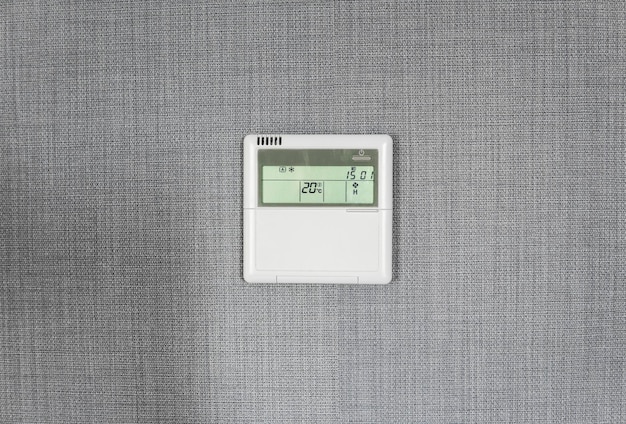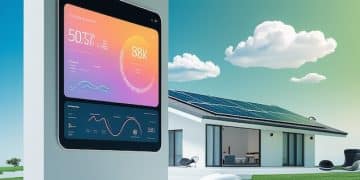Top 5 Smart Thermostat Features to Maximize Winter Savings in US Homes

Anúncios
Smart thermostats offer advanced features like geofencing, zoning, and detailed energy reporting that empower US homeowners to significantly reduce heating costs and enhance comfort during the winter months, maximizing energy efficiency and financial savings.
As winter’s chill descends upon US homes, the thermostat often becomes the most-used household appliance, directly impacting comfort and, more significantly, utility bills. Embracing smart home technology now provides a powerful solution to this annual dilemma: Top 5 Smart Thermostat Features to Maximize Savings This Winter in US Homes. These intelligent devices go beyond simple temperature control, offering sophisticated functionalities designed to optimize energy consumption and deliver tangible cost reductions, making them an indispensable upgrade for any forward-thinking homeowner.
Understanding Smart Thermostats: Beyond Basic Control
Smart thermostats are revolutionizing how American households manage their indoor climate. Unlike their traditional counterparts, these devices leverage advanced connectivity and intelligent algorithms to learn user preferences, respond to external conditions, and provide unprecedented control over home heating and cooling. This evolution from simple on/off switches to sophisticated energy management hubs is precisely what makes them so effective at generating savings, particularly when faced with the high heating demands of winter.
Initially, early programmable thermostats promised savings by allowing users to set schedules. However, most homeowners found these difficult to program or simply overrode them, negating any potential benefits. Smart thermostats overcome these limitations by introducing intuitive interfaces, remote access, and, crucially, learning capabilities. They adapt to your lifestyle, ensuring that energy isn’t wasted heating an empty home or overcooling one when you’re away. This seamless integration into daily life, combined with a focus on both comfort and efficiency, marks a significant leap forward in residential energy management.
The core of a smart thermostat’s ability to save money lies in its intelligence. It’s not just about setting a temperature; it’s about anticipating needs, reacting to changes, and providing insights that empower the homeowner to make smarter energy choices. As we delve into the specific features that drive winter savings, it becomes clear that these devices are more than just gadgets—they are strategic investments for a more efficient and comfortable home.
1. Geofencing: Heating When You’re Home, Saving When You’re Not
Geofencing is arguably one of the most compelling features of modern smart thermostats, offering an intuitive and effortless way to save energy. This technology utilizes the location services of your smartphone to detect when household members are approaching or leaving the home.
The principle is simple yet profoundly effective:
- Once the last person leaves a predefined “geofence” (a virtual boundary around your home), the thermostat automatically adjusts the temperature to a more energy-efficient setting, reducing heating without manual intervention.
- When the first person re-enters the geofence, the thermostat begins heating the home back to your preferred comfortable temperature, ensuring it’s warm and inviting upon arrival.
This eliminates the common energy waste associated with heating an empty house or forgetting to turn down the thermostat before leaving. Imagine never having to worry about adjusting the heat before going to work or returning to a chilly home after a long day. Geofencing handles it seamlessly, translating directly into lower energy consumption and significant cost savings over the winter months. For US homeowners, where daily routines are common, this feature offers unparalleled convenience and efficiency.
Many smart thermostats allow customization of geofencing parameters, such as the size of the geofence and the specific temperature setbacks. Some can even identify individual family members, ensuring that the home only adjusts its temperature when absolutely everyone has left. This level of personalized, automated control removes the guesswork from energy management, making it an indispensable tool for maximizing savings without sacrificing comfort. The data consistently shows that properly utilized geofencing leads to measurable reductions in heating costs, often making it one of the quickest returns on investment for smart thermostat adoption.
2. Advanced Scheduling & Learning Algorithms: Optimized Comfort and Efficiency
While basic programmable thermostats struggled with user adoption, smart thermostats excel with their advanced scheduling capabilities, often augmented by sophisticated learning algorithms. These features mean your thermostat isn’t just following a predetermined timetable; it’s actively learning and adapting to your family’s routines and preferences.
The core benefit lies in:
- Adaptive Learning: Over days and weeks, the thermostat observes your adjustments, recognizing patterns of when the house is occupied and what temperatures you prefer at different times. It then proposes or automatically implements a schedule that aligns with your lifestyle.
- Weather Integration: Many smart thermostats pull local weather forecasts, allowing them to pre-heat (or pre-cool) your home more efficiently. For instance, if a sudden cold snap is predicted, the system might adjust its heating strategy to ensure comfort is maintained without last-minute energy surges.
- Smart Away: Building on learning, this feature goes beyond simple geofencing by using occupancy sensors within the thermostat or connected smart home devices to detect if the house is truly empty. If no activity is detected for an extended period, it automatically switches to an economy mode, saving energy even if a geofence hasn’t been triggered.
This intelligent approach means you rarely have to manually intervene. The thermostat takes the guesswork out of energy efficiency, optimizing heating cycles based on real-time data and historical patterns. For example, if you consistently turn down the heat before bedtime, the thermostat will learn this and eventually automate that adjustment. This “set it and forget it” functionality is crucial for maximizing winter savings, as it ensures your home is only heated when it needs to be, avoiding wasteful temperature maintaining during unoccupied hours.
3. Zoning Capabilities & Remote Sensors: Targeted Heating for Maximum Savings
For homes with multiple levels, unused rooms, or varying temperature preferences among occupants, zoning capabilities combined with remote sensors offer a powerful solution for significant energy savings. Traditional thermostats only read the temperature at a single point, often leading to uneven heating and wasted energy in areas that don’t need it.
This feature allows you to:
- Divide Your Home into Zones: With multiple smart thermostats or a single smart thermostat connected to multiple dampers in your HVAC system, you can create distinct heating zones. This means you can heat only the rooms or areas you’re actively using, rather than the entire house.
- Utilize Remote Sensors: These small, often wireless, sensors can be placed in different rooms. They communicate ambient temperature back to the main thermostat, ensuring that the reading used for heating is accurate for the occupied space, not just the hallway where the main thermostat is located. Some sensors also include occupancy detection, further informing the system.
Consider a detached single-family home in the US: during the night, there’s no need to heat the living room or kitchen to the same degree as the bedrooms. With zoning, you can set back the temperature in those unused zones while maintaining comfort in sleeping areas. Similarly, remote sensors can ensure a baby’s nursery maintains a precise temperature, independent of fluctuations in other parts of the house. This targeted heating prevents energy waste by not over-heating unoccupied or less-used areas, leading to substantial reductions in your winter energy bill.
The beauty of this feature lies in its ability to deliver personalized comfort while simultaneously maximizing efficiency. It addresses the common problem of “hot and cold spots” in a home, ensuring that warmth is delivered precisely where and when it’s needed most. This nuanced control over your heating system is a cornerstone of modern energy management, offering a sophisticated pathway to considerable savings.

4. Energy Reporting & Smart Home Integration: Data-Driven Savings and Seamless Control
Understanding your energy consumption is the first step towards reducing it, and smart thermostats excel at providing insightful energy reporting. Beyond simply setting temperatures, these devices collect and present data on your heating patterns, energy usage, and even the impact of external factors like weather. This analytical capability transforms abstract energy consumption into actionable intelligence, empowering homeowners to make more informed decisions about their heating:
- Detailed Usage Reports: Access historical data through an app or web portal, showing how much energy you’re using daily, weekly, or monthly. This allows you to identify trends, pinpoint periods of high consumption, and track the effectiveness of your energy-saving strategies.
- Savings Estimates: Many smart thermostats provide estimates of the energy saved through their features, giving you a tangible sense of the value they deliver.
- Tips for Optimization: Based on your usage data, some systems offer personalized recommendations for further efficiency improvements, such as ideal setback temperatures or schedule adjustments.
Furthermore, smart home integration extends the utility and efficiency of your smart thermostat exponentially. By connecting with other smart devices, the thermostat can become part of a larger, more intelligent ecosystem:
- Voice Control: Integrate with smart speakers (e.g., Amazon Alexa, Google Assistant) for hands-free temperature adjustments.
- Light & Shade Synchronization: Link with smart lighting or automated shades. For example, in winter, open smart shades during sunny periods to leverage passive solar gain and lower heating demand, then close them at night for insulation.
- Occupancy Sensors & Motion Detectors: Integrate with dedicated smart home sensors to provide more granular occupancy data, refining “Smart Away” features and ensuring heating is only active when needed.
- IFTTT (If This Then That) Recipes: Create custom automations; for example, “If outdoor temperature drops below freezing, then set indoor temperature to X,” or “If all lights are off and no motion detected for 30 minutes, set thermostat to away mode.”
These integrations create a truly responsive and adaptive home environment that is inherently more energy-efficient. The synergy between data reporting and smart home connectivity transforms your heating system from an isolated unit into an intelligent participant in your home’s overall energy management strategy, leading to deeper and more consistent savings throughout the cold winter months.
5. Compatibility & Professional Installation Considerations: Maximizing Performance
Ensuring your chosen smart thermostat is fully compatible with your existing HVAC system is paramount for maximizing its performance and, by extension, your winter savings. Not all smart thermostats work with every type of heating system, and some require specific wiring configurations like a “C-wire” (common wire) for continuous power. A basic understanding of these requirements can prevent installation headaches and ensure optimal operation.
Key compatibility factors include:
- HVAC System Type: Verify if your system is conventional, heat pump, or zoned. Most major smart thermostat brands support a wide range, but double-checking is crucial.
- C-Wire Requirement: Many smart thermostats need a continuously powered C-wire for consistent operation. If your older home lacks one, professional installation might involve running a new wire or using a power extender kit.
- Voltage and Stages: Ensure the thermostat matches your system’s voltage and number of heating/cooling stages (e.g., single-stage, multi-stage).
While many smart thermostats are designed for DIY installation, especially those that come with clear instructions and in-app guides, there are scenarios where professional installation is highly recommended, or even necessary. This is especially true for complex systems, multi-zone setups, or homes without a C-wire.
The benefits of professional installation include:
- Correct Wiring: Avoiding costly errors that could damage your HVAC system or the thermostat.
- Optimal Configuration: Ensuring the thermostat is properly calibrated and configured for your specific heating and cooling equipment, maximizing efficiency and comfort.
- System Integration: Professionals can ensure seamless integration with other smart home components if you’re building a larger ecosystem.
- Warranty Preservation: Some HVAC manufacturers may require professional installation to maintain warranty validity.
Investing in proper installation guarantees that your smart thermostat operates at peak efficiency, fully leveraging its advanced features to deliver the projected energy savings. This is particularly important for US homeowners aiming to make a lasting impact on their winter utility bills, avoiding potential issues that untrained installation might cause. A correctly installed and configured smart thermostat performs reliably, providing consistent comfort and maximizing its inherent cost-saving potential throughout the coldest months.

Choosing the Right Smart Thermostat for Your US Home
Selecting the ideal smart thermostat involves more than just picking a popular brand; it requires a careful evaluation of your specific home, lifestyle, and heating needs. The US market offers a diverse range of options, each with unique strengths. For example, while some excel in their intuitive learning algorithms, others might stand out for their robust multi-zone capabilities or extensive smart home ecosystem integration. Consider factors like the size of your home and its layout. A larger home with distinct areas may benefit significantly from advanced zoning features, allowing you to fine-tune temperatures in different sections, thus avoiding overheating unused areas.
Your daily routine also plays a crucial role in deciding which features will offer the most value for money. If your family has unpredictable schedules, geofencing will be a game-changer, automatically adjusting temperatures as people come and go. Conversely, if you have a very stable daily routine, a thermostat with highly customizable advanced scheduling might be sufficient, ensuring warmth only when needed. Don’t overlook the importance of user interface and app functionality. An intuitive app that provides clear energy reports and easy control will encourage regular use and engagement with the thermostat’s money-saving features, leading to deeper long-term savings.
Ultimately, the best smart thermostat for you is one that seamlessly integrates into your existing home setup and lifestyle, making energy efficiency effortless rather than a chore. Researching various models, reading user reviews, and comparing feature sets against your priorities will help you make an informed decision that pays dividends in comfort and reduced utility bills throughout the winter. Remember, an investment in a smart thermostat is an investment in long-term energy independence and savings for your US home.
| Key Feature | Benefit for Savings |
|---|---|
| 📍 Geofencing | Automatically adjusts temperature based on your proximity, preventing heating empty homes. |
| 🧠 Learning Algorithms | Learns your patterns for optimized scheduling, reducing manual adjustments and waste. |
| 🏠 Zoning & Sensors | Heats specific areas, eliminating energy waste in unused rooms. |
| 📊 Energy Reporting | Provides data insights to track consumption and identify further saving opportunities. |
Frequently Asked Questions About Smart Thermostats
Savings vary based on climate, home insulation, and individual habits, but many US homeowners report 10-15% reductions in heating costs. Features like geofencing and smart scheduling significantly contribute by preventing energy waste when the home is unoccupied or during off-peak hours.
Most smart thermostats benefit from a C-wire for reliable continuous power. However, some models use alternative power methods, like power extenders or rechargeable batteries. Checking your HVAC system and thermostat’s power requirements before purchase is crucial for smooth installation and operation.
Yes, many popular smart thermostats offer broad compatibility with major smart home platforms such as Amazon Alexa, Google Assistant, Apple HomeKit, and Samsung SmartThings. This allows for centralized control, voice commands, and automation routines that enhance energy efficiency and convenience.
While many smart thermostats are designed for DIY installation, professional help is recommended for complex HVAC systems, multi-zone setups, or if your home lacks a C-wire. This ensures correct wiring, optimal performance, and can prevent potential damage or warranty issues.
Learning algorithms observe your manual temperature adjustments and daily routines over time. They then propose or automatically implement heating schedules that align with your lifestyle, pre-heating the home before you arrive or setting back temperatures when you’re away, optimizing comfort and energy use.
Conclusion
Embracing smart thermostat technology is more than just a trend; it’s a strategic move for US homeowners looking to gain greater control over their energy consumption and significantly reduce winter heating bills. The advanced features discussed—geofencing, learning algorithms, zoning capabilities, energy reporting, and seamless smart home integration—collectively transform a basic temperature control device into a powerful energy management tool. By intelligently adapting to your lifestyle and home’s specific needs, these thermostats ensure you achieve optimal comfort while minimizing waste, leading to tangible savings. As technology continues to evolve, smart thermostats stand as a testament to how innovation can directly translate into a more efficient, comfortable, and cost-effective home environment, making them an invaluable investment for navigating the colder months ahead.





